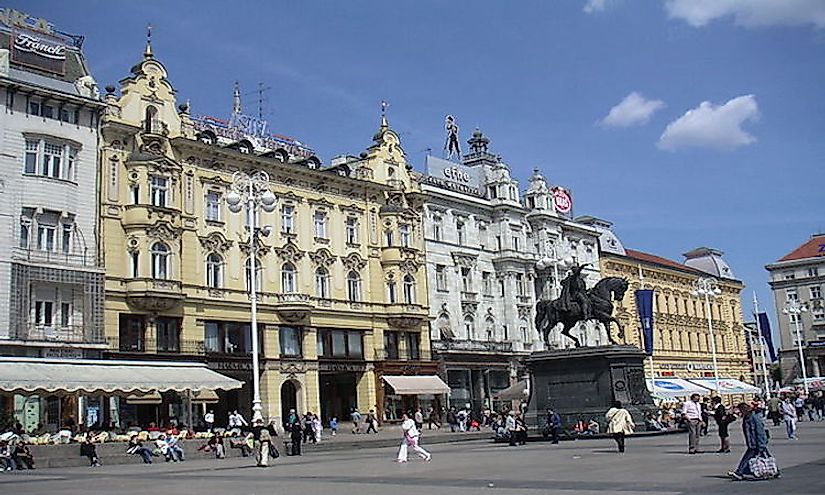Biggest Cities In Croatia

The Biggest Cities In Croatia
Croatia covers an area of 21,851 square miles and is the 127th largest country in the world. Major rivers like Sava, Danube, and the Kupa traverse the hilly northern parts and the flat southeastern plains of Croatia. The central and southern regions contain low mountains and forested highlands. Most of the country includes karst topography, particularly in the Dinaric Alps. Croatia is highly-urbanized with many cities and towns, Zagreb city being the largest and the seat of the Republic.
The Five Biggest Cities Of Croatia
Zagreb
Zagreb is the biggest and the capital city of Croatia, located in the northwest of the country along Sava River. It lies at an altitude of approximately 400 ft above sea level and supports a population of 792,875. Its rich history dates back to the Roman period in 1094 AD when King Ladislaus returned from a campaign against Croatia and formed a diocese called Kaptol with a neighboring Gradec town. Ban Josip united the two settlements of Kaptol and Gradec in 1851. The city experiences an oceanic climate with four distinct seasons, summer, autumn, winter, and spring without a definite dry season. In winter the temperature drops to an average of 1 degree Celsius, and in summer it rises to up to 22 degrees Celsius. Winter months commonly experience snowballs and autumn months have rain and fog. Zagreb contains 17 city districts and 218 local committees for local governments. It is an international trade and business center with industries such as electricity production, textile, chemical and pharmaceutical, and food and drink. It has an integrated transport system of highways, roads, and bridges, and is the hub of 5 major Croatian highways, which usually started or ended in Zagreb. It has numerous museums that reflect the pre-civilization culture that existed in Zagreb, Croatia, and Europe at large including the archeological museums, gallery museum, and technical museums among others.
Split
The split city comes second among the major cities in Croatia and is the largest in Dalmatia region. Its territory includes the neighboring seaside towns making the city a favorite beach resort center both for the locals and international personalities. It is among the oldest cities in Croatia founded as a Greek colony of the Aspalathus in the 4th century. In 650 CE it became a Byzantine city then later conquered by Venice and became a Venetian city. It experiences humid subtropical and Mediterranean climates. Its summers are hot and moderately dry, and the winters are cold. Average annual rainfall is 820 mm and above. July experiences the hottest temperatures of up to 30 degrees Celsius. The city is one of the centers of Croatian culture and is listed by UNESCO as a world heritage site. There are 23 high schools, 24 primary schools and the University of Split, all located in the city. It is also a major transport center for Dalmatia region with a well-defined series of expressways and road networks for efficient and fast transportation in an out of the city.
Rijeka
Rijeka is a major seaport of Croatia, located on the Kvarner bay. Its location as a seaport made it a much-contested city between Italians, Hungarians, and Croatians. It is a major marine center, with its leading economy depending on the shipbuilding and water transport. Most occupants are Croatians with negligible numbers of Bosniaks, Serbs, and Italians. Most people speak Croatian with a Venetian dialect called fiumano. It experiences a humid subtropical climate with warm, pleasant summers, very rare snow in winter, a temperature of 0-30 degrees Celsius and frequent rainfall. Major sights in the city include the torpedo factory, the sanctuary of our Lady of treat and the old gate.
Osijek
Hosting a population of 108,048, Osijek is the fourth largest city in Croatia. Major institutions include the Museum of Slovenia, creation national theater and the University of Osijek. Saponia chemical factory is the biggest factory in the area, and a major producer of detergents, cosmetics, and soap. Main transport links include the railway and highway, river port and an airport.
Zadar
The Zadar city covers a total of 25 square kilometers and has a population of 75, 082. Most settlements in the city date back to the Neolithic period while others date back to the Stone Age period. Founded in the 4th Century by the Liburnians, Zadar experienced successive kingdom struggles until 1991 when Croatian army defended it from the hands of the Serbs. It is a major cultural center for Croatia, and in the 19th century, it was a center for the creation movement for cultural and national revival. Main sights of Zadar include the Roman Forum, the church of St Donatus, and St. Mary's church.
Importance Of The Cities
Croatia has a total of approximately 128 cities and towns that vary with the population size. More than half of the people of Croatia live in urban centers. Other notable cities of Croatia include Velika Gorca, Slavonski Brod, Pula, Karlovac, Sisak among others. The cities serve various functions such as education centers, industrial and economic centers, transport centers and cultural centers. The government of the Republic has reserved the significant historical and archeological sites found in various cities.











